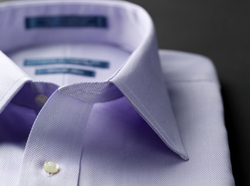We see commentary on women’s clothing all the time, but we rarely see much said about men’s clothes outside men’s fashion magazines, which are, let’s face it, an oxymoron. My own tendency has been to pity men for the lack of variety in their apparel. How sad to have to constantly replenish those bland staples: the tie, the trouser, the buttoned shirt. And yet, as someone who knows that a sonnet can be more richly satisfying than free verse, I also recognize that limitation can be a spur to creativity.
Which is why, recently, I leveled my gaze at the men’s buttoned shirt in the hope that it might yield insight into the subtle expressiveness of the male wardrobe. Once I began to look, I saw more than I bargained for. In fact, I came away dazzled by the understated excess of the garment, its marvelously inhibited expressiveness, its discreet union of the utilitarian and the gratuitous.
Let us start at the top with the collar, a device that seems to demand theorizing. The cut of the collar with its sharp indentation under the chin makes it a kind of pedestal for the face. It seems to say: “Take note: Here sits the head of a man.”
To shift metaphors from the static to the organic, the collar of the man’s shirt, with its thick and creamy folds, is like a flower turned upside down: the neck and head extending out like stem and bulb.
The collar is also designed for the tie, an accessory so blatantly useless and so phallicly suggestive that one wonders how it could possibly have passed the 20th-century’s Legion of Decency codes, no less Victorian ones, which mandated that chair legs wear skirts. One can only assume that when something is that in-your-face, no one sees it — a lesson that some politicians have taken to heart.
As originally designed, the collar was detachable, like the tie. One could speculate on why this was and why it changed. Ostensibly, the detachable collar (and cuffs) facilitated more targeted starching and cleaning. Given the abundance of Industrial Era dirt and grime, “ring around the collar” (what later detergent advertisers made the bane of serious housewives) could be efficiently mitigated. But more theoretical explanations are also possible. Perhaps the 19th-century man only needed to give emphasis to his head in public settings; at home, he could disregard this part of his anatomy, either because he deferred to his wife’s judgment or, contrarily, because brute force could serve him in lieu of brain power. Whatever the reason, in the 20th century, the collar ceased to be detachable. Public and private became less differentiated.
Button-down collars were introduced by Brooks Brothers in the 1896 and were relatively slow to gain traction, men being by nature conservative on the sartorial front (which raises the question of how such weird innovations as spats and the Nehru jacket made it, even briefly, into the male wardrobe). My research shows that the buttoned collar was first worn by polo players who didn’t want their collars flopping around as they played. What seems noteworthy here is that guys were wearing buttoned shirts to play polo — you don’t get more uptight British than that. Eventually, the buttoned collar recommended itself to men who didn’t play polo, sort of the way Land Rovers appeal to guys who never drive anywhere beyond suburban New Jersey. Soon buttoned collars were pretty standard.
Until recently I assumed that the phrase “button-down shirt” meant a shirt that buttoned down, but I have since learned that this refers exclusively to the button-down collar worn by all those polo- and non-polo-playing guys. All other shirts are called dress shirts, even if they’re made of polyester and have Hawaiian prints. This seems pretty odd, though no odder I guess than wearing button-down shirts to play polo.
In its original manifestation, the button-down shirt — excuse me, the dress shirt — was always white. Since that time it has become available in many colors and patterns. Personally, I like a light pink shirt on a man. Pink happens to be my favorite color and when men wear it I think they’re sensitive. Pink also flatters the complexion, and since men don’t (generally) wear makeup they need all the help they can get in this area.
At its best, the dress shirt should evoke the sail of a ship, the fabric billowing out in a natural, easy fashion — not so loose as to seem sloppy but free enough to flatter the body beneath. One doesn’t expect a shirt to make a difference in a man’s appearance, but it does. In a good shirt, the paunchy and spindly can look dashing and fit; in a not so good one, paunchy and spindly.
When we get to the cuffs of a dress shirt, things begin to get interesting. The thicker fabric of the cuff mimics the thicker fabric of the collar, but cuffs are straight not angled, thereby announcing that the hands are lower than the head: important appendages but secondary. Buttoned cuffs make a man seem efficient, all-business, but if he has French cuffs the effect is softened, even undermined. The sparkle or whimsy of the cuff link provides a touch of the idiosyncratic and the egotistical. This goes against the general grain of the dress shirt which is, superficially, a self-effacing garment. A man who wears cuff links must be prepared either to flaunt his dandyism unabashed or assert his manliness in other, more explicit ways.
Cuffs — whether cuff-linked or simply buttoned — mean that business is in progress, but there is nothing sexier than a man in shirtsleeves with his cuffs rolled up. For me, the quintessential image of manliness is the jacket swung over the shoulder, the tie loosened, and the sleeves rolled to the elbow. No one does this look better than John Hamm in Mad Men — indeed, the ’50s and early ’60s was the heyday of the dress shirt, both in its formal and its more relaxed aspect.
Most dress shirts have a small pocket over the left breast. The British tend to omit this feature, and bespoke (i.e. made-to-order) shirts tend to put a monogram there instead. I don’t see much purpose in the pocket myself, unless a man falls into one of two distinct categories: the nerd, who will use the pocket for pencils and tic tacs, and the hipster, who will use it for cigarettes or more illicit smokable substances.
The panel at the front of the shirt where the buttons are sewn is called the placket. Men have their placket on the right side; women on the left, thereby defining the difference between a shirt and a blouse. This is a distinction I hadn’t known until recently, and why I used to annoy my husband by asking him if he wanted me to iron his blouse.
The buttons at the front of the shirt are the shirt’s raison d’être. They are the access route, the gateway to the body. They announce that getting in is possible but not easy. Keep the shirt buttoned to the top and the effect is formal — stiff and stodgy, gracious and respectful, depending on the man and the occasion. Unbutton a few buttons and you say fatigue, stylish insouciance, or phony hipness. Unbutton at random and you say sloppy or slapdash, and, if occurring in the stomach area, fat. Unbutton all the way, and you say passion or extreme relaxation. As for shirt tails, in their double nature and dramatic curves, they can promise or threaten. Some men look sexy with shirttails out; others simply look like slobs.
With the shirt off, of course, there’s nothing more to say — unless you want to start in on the undershirt. That too speaks volumes.
• 2 November 2010
 |




